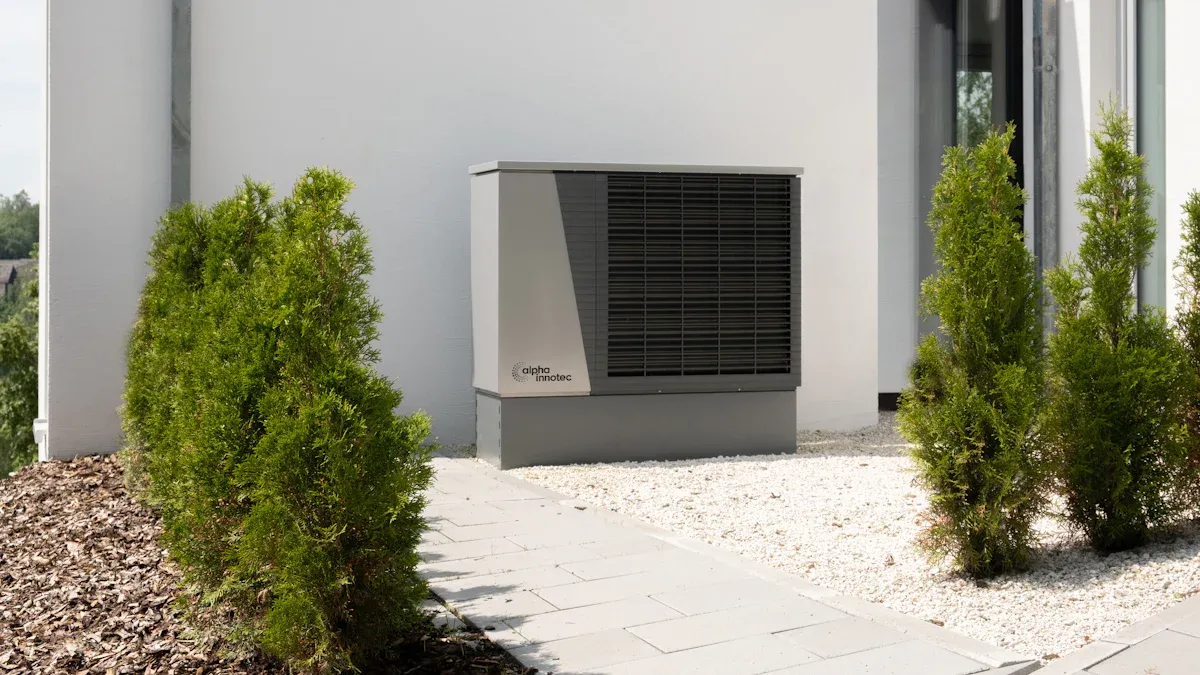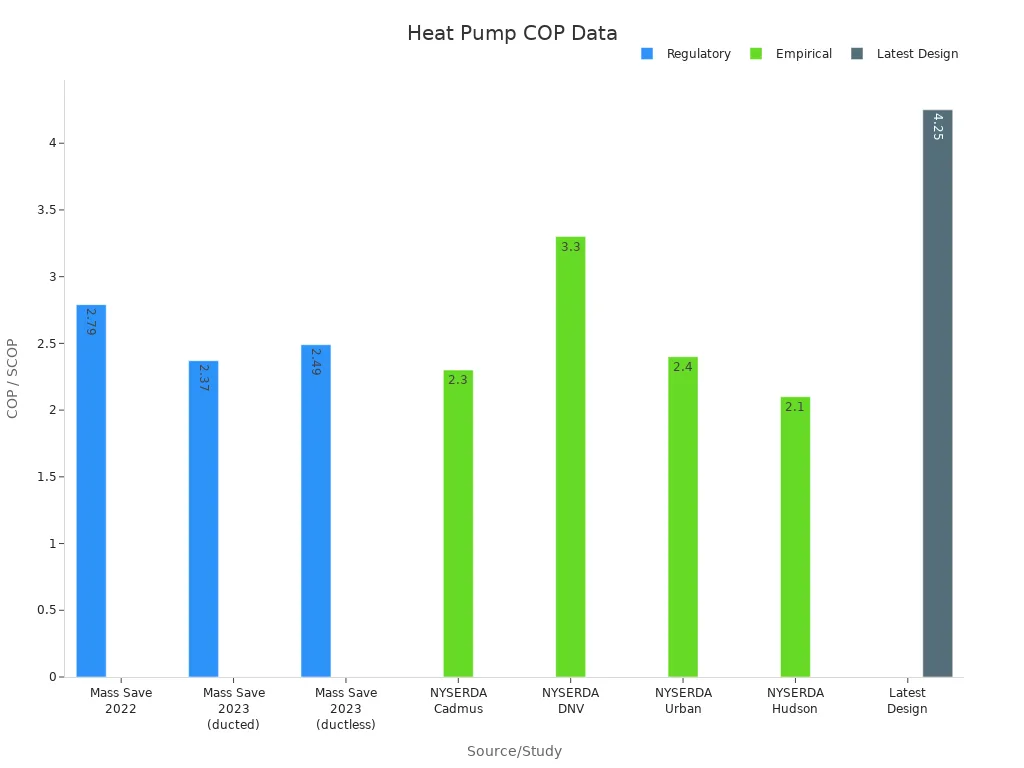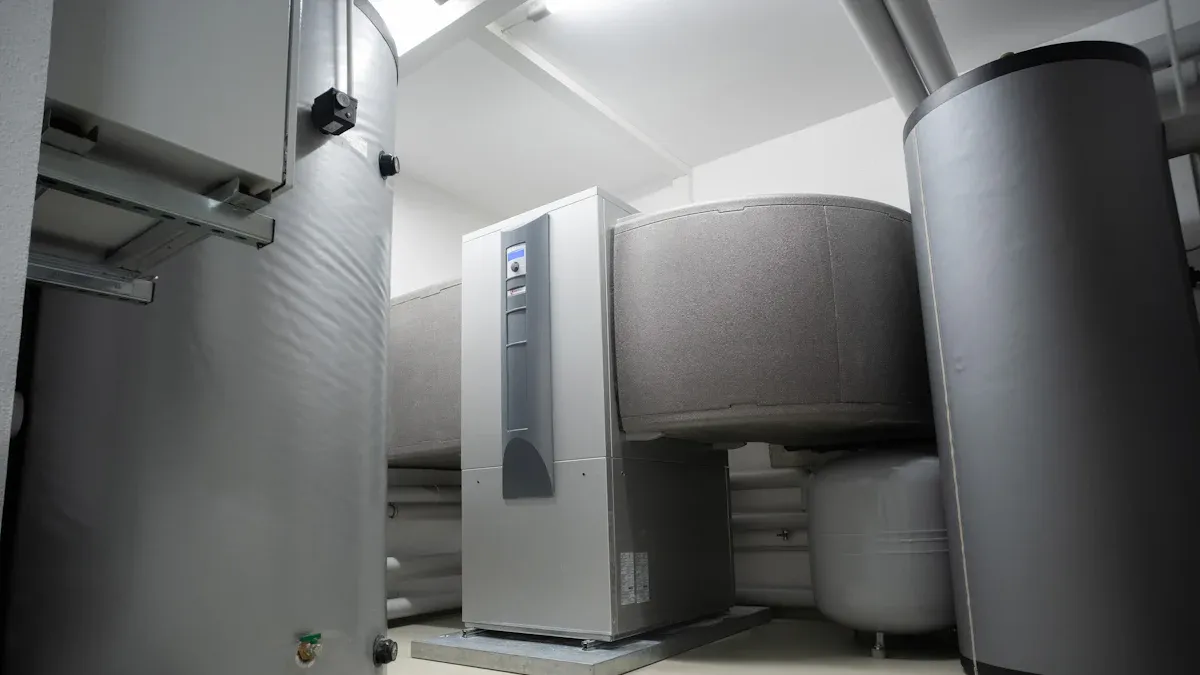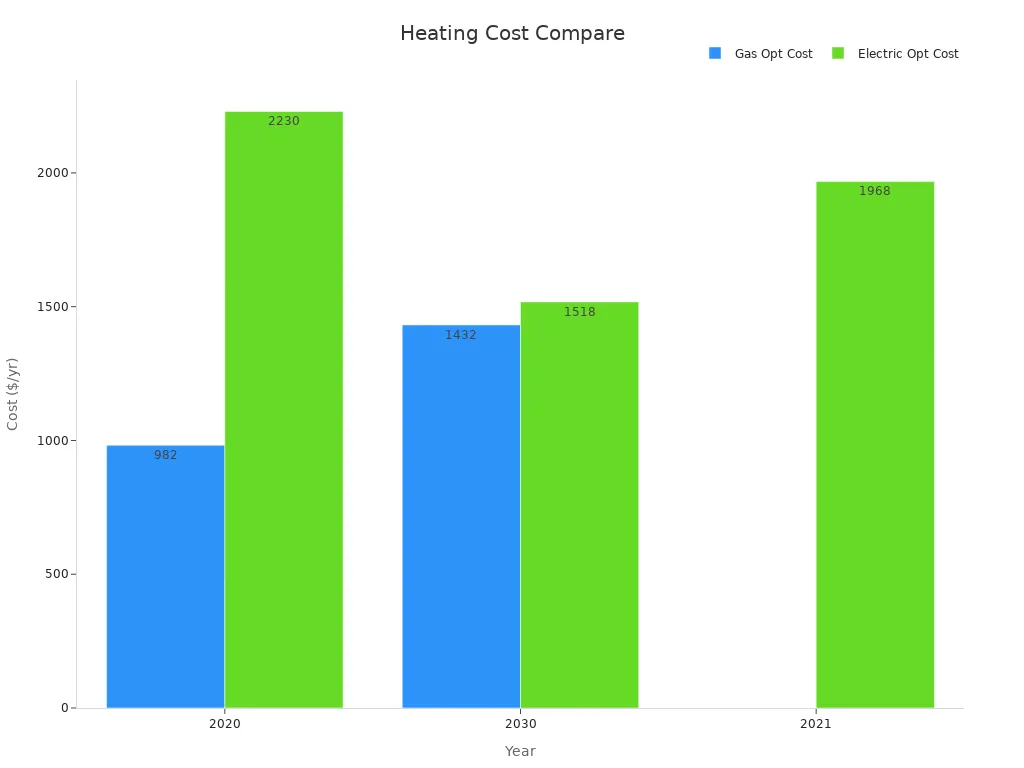
Cuando se comparan las opciones de calefacción, la bomba de calor destaca como sistema de calefacción energéticamente eficiente. A diferencia de una tira de calefacción que se basa en la resistencia eléctrica, una bomba de calor mueve el calor en lugar de generarlo, lo que la hace mucho más eficiente desde el punto de vista energético. De hecho, las bombas de calor pueden transferir hasta 300% más de energía que la electricidad que consumen, mientras que la calefacción eléctrica suele utilizar De 3 a 4 veces más energía para el mismo rendimiento. Considere los siguientes datos de rendimiento recientes:
| Métrica Descripción | Valor numérico | Contexto/Año |
|---|---|---|
| COP medio de la unidad de bomba de calor (2023) | 8.9 | Temporada de refrigeración 2023 |
| Tasa de ahorro de energía mediante controles avanzados | 7.84% | Tasa de carga 30%-50% |
Puede alcanzar sus objetivos de eficiencia energética y disfrutar de facturas más bajas eligiendo el sistema de calefacción adecuado.
Cómo funcionan las bombas de calor y las cintas calefactoras eléctricas

Funcionamiento y eficiencia de la bomba de calor
Cómo mueven el calor las bombas de calor
Usted se beneficia de una bomba de calor porque desplaza el calor en lugar de generarlo. El sistema utiliza un ciclo de refrigeración y una válvula de inversión para transferir calor del exterior al interior de la vivienda. Este proceso se basa en un compresor y refrigerantes, que permiten a la bomba de calor suministrar de dos a cuatro veces más energía térmica que la electricidad que consume. La física de la transferencia de calor y la termodinámica lo hacen posible. Cuando las temperaturas exteriores bajan mucho, las cintas calefactoras de la bomba de calor pueden activarse como apoyo. Estas cintas calefactoras auxiliares aumentan el consumo eléctrico, pero rara vez son necesarias en climas suaves.
- Las bombas de calor transfieren el calor del exterior a su vivienda mediante una válvula inversora y un ciclo de refrigeración.
- Las cintas calefactoras de las bombas de calor actúan como elementos calefactores de reserva, generando calor directamente cuando las temperaturas exteriores son demasiado bajas.
- Las bombas de calor son más eficientes que las cintas calefactoras eléctricas porque mueven el calor en lugar de generarlo.
- Las bombas de calor tienen unos costes iniciales más elevados, pero unos costes de funcionamiento inferiores en comparación con las cintas de calor eléctricas.
- La eficiencia disminuye a temperaturas muy bajas, por lo que las cintas calefactoras de apoyo mantienen el confort interior.
Tipos de bombas de calor: De aire y de suelo
Puede elegir entre sistemas de bomba de calor aerotérmica o geotérmica. Las bombas de calor aerotérmicas extraen el calor del aire exterior, por lo que son muy populares para uso residencial. Las bombas de calor geotérmicas extraen el calor del suelo, que se mantiene a una temperatura más constante durante todo el año. Los sistemas geotérmicos suelen ser más eficientes, pero su instalación es más costosa y requiere más espacio. Ambos tipos utilizan los mismos principios de transferencia de calor, pero su rendimiento varía en función del clima y la propiedad.
Consejo: A la hora de elegir un sistema de bomba de calor, tenga en cuenta el clima local y el espacio disponible. Las unidades geotérmicas son más eficientes, pero requieren una mayor inversión inicial.
Funcionalidad de la cinta calefactora eléctrica
Cómo funciona la calefacción por resistencia eléctrica
Una tira calefactora funciona convirtiendo la energía eléctrica directamente en calor. Cuando la corriente pasa a través de los elementos resistivos del interior de las bandas calefactoras eléctricas, los elementos se calientan y calientan el aire que circula por su sistema. Este método alcanza un Coeficiente de Rendimiento (COP) de 1,0, lo que significa que el sistema convierte 100% de la electricidad en calor, pero no amplifica la energía como lo hace una bomba de calor. La simplicidad de este proceso hace que las bandas de calor eléctricas sean fiables, pero consumen más energía para la misma cantidad de calor.
Usos habituales de las cintas calefactoras eléctricas
Las cintas calefactoras eléctricas suelen utilizarse como fuentes de calor auxiliares o de emergencia. Cuando las temperaturas exteriores bajan por debajo de 40°Fo cuando se sube rápidamente el termostato, la tira calefactora se activa para proporcionar calor adicional. Estas tiras sirven de apoyo a las bombas de calor en caso de frío extremo o cambios bruscos de temperatura. Usted puede maximizar la eficiencia manteniendo su termostato alrededor de 68 °F y haciendo ajustes graduales. Un mantenimiento regular, como la inspección de daños y la limpieza, garantiza que las bandas calefactoras eléctricas funcionen bien y duren más.
- Las cintas calefactoras eléctricas funcionan por resistencia eléctrica, generando calor cuando la corriente pasa a través de elementos resistivos.
- Las bandas de calor se activan principalmente cuando las temperaturas exteriores descienden por debajo de 40 °F o cuando los ajustes del termostato aumentan rápidamente.
- Sirven como fuente de calor suplementaria fiable en condiciones de frío cuando las bombas de calor por sí solas son insuficientes.
- Los inconvenientes son un mayor consumo de energía y una posible distribución desigual del calor.
Comparación del consumo de energía: Ventajas e inconvenientes de la calefacción eléctrica
Clasificación de eficiencia energética
COP (coeficiente de rendimiento) de las bombas de calor
Debe prestar mucha atención al Coeficiente de rendimiento (COP) a la hora de comparar sistemas de calefacción. El COP mide la cantidad de calor que produce un sistema por cada unidad de electricidad que consume. La mayoría de las bombas de calor modernas alcanzan un COP de entre 2,0 y 3,3 en condiciones reales, lo que significa que se obtiene dos o tres veces más calor que electricidad consumida. Algunos diseños avanzados pueden incluso alcanzar COP instantáneos de 4 a 4,5 durante los ciclos de calefacción óptimos. Este nivel de eficiencia energética hace que las bombas de calor destaquen como solución de calefacción energéticamente eficiente.
El COP estacional (SCOP) promedia el rendimiento durante toda una temporada de calefacción, teniendo en cuenta los cambios de temperatura y el funcionamiento del sistema. Las normas reguladoras, como las del programa Mass Save, exigen valores mínimos de SCOP en torno a 2,4 y 2,8 para los incentivos. Los estudios empíricos muestran que la mayoría de los hogares experimentan COP estacionales en el 2,0 a 3,3 ligeramente inferiores a las de laboratorio debido a factores del mundo real.

Nota: Un COP más alto significa una mayor eficiencia energética y un menor consumo de energía para la misma cantidad de calor.
Eficacia de las cintas calefactoras eléctricas
Una banda calefactora funciona con un COP de 1,0. Esto significa que convierte cada unidad de electricidad directamente en calor, pero no multiplica la producción como una bomba de calor. Aunque este proceso es sencillo y fiable, da lugar a un mayor consumo de energía para la misma potencia calorífica. Las cintas calefactoras eléctricas no ajustan su eficiencia en función de la temperatura exterior, por lo que siempre se utiliza la misma cantidad de electricidad por cada unidad de calor producida.
Consumo de energía en el mundo real
Uso típico de la energía en el hogar
Notará una diferencia significativa en el consumo de energía al comparar las bombas de calor y las cintas calefactoras eléctricas en hogares reales. Por ejemplo, cuando hace frío, a unos 29°F, una bomba de calor suele consumir unos 60 kWh al día, mientras que las cintas calefactoras eléctricas pueden consumir hasta 175 kWh durante el mismo periodo. Esto significa que la bomba de calor consume aproximadamente un tercio de energía que una tira de calefacción en condiciones similares.
| Métrica | Bomba de calor | Tiras de calor eléctricas |
|---|---|---|
| Consumo de electricidad (kWh) | 1,7 kWh | 4,9 kWh |
| Consumo (medio) | 2,036 W | 9,844 W |
| Tiempo de funcionamiento (minutos, periodo de prueba) | 40 (con bomba de calor) | 17 (sólo tiras térmicas) |
| Consumo de energía (kWh/día) | ~60 kWh (a ~29°F) | ~175 kWh (a ~29°F) |
| Consumo relativo de energía | Línea de base | ~3 veces más electricidad |
Puede ver que la bomba de calor proporciona una forma mucho más eficiente de calentar su hogar, especialmente en climas moderados.
Impacto en las facturas de servicios públicos
Su factura eléctrica refleja las diferencias de consumo de energía entre estos sistemas. Dado que una bomba de calor utiliza menos electricidad para producir la misma cantidad de calor, pagará menos cada mes en comparación con el uso de bandas calefactoras eléctricas como fuente principal de calefacción. Los estudios demuestran que el funcionamiento de una bomba de calor cuesta aproximadamente un tercio que el de una regleta de calefacción para la misma potencia calorífica, suponiendo que la necesidad de calor suplementario sea mínima. Sin embargo, en climas más fríos, la fracción de calor suplementario puede aumentar a 40%lo que aumenta el consumo total de energía y los costes de funcionamiento.
Consejo: El dimensionamiento y la instalación adecuados de su bomba de calor pueden minimizar la necesidad de tiras de calefacción suplementarias, maximizando su ahorro y confort.
Ventajas e inconvenientes de la calefacción eléctrica
Cuando evalúe el pros y contras de la calefacción eléctricaEn cualquier caso, hay que tener en cuenta tanto el rendimiento como la practicidad. Los estudios comparativos destacan varios puntos importantes:
- Los sistemas de calefacción eléctricos, incluidas las bombas de calor y las cintas calefactoras, ofrecen una instalación sencilla, un mantenimiento reducido y un funcionamiento respetuoso con el medio ambiente.
- Las bombas de calor ofrecen la mayor eficiencia energética y el menor consumo de energía entre las opciones eléctricas.
- Las bandas calefactoras proporcionan calor de apoyo o primario fiable en climas fríos, pero suponen mayores costes de electricidad y una calefacción menos eficiente para toda la casa.
- Los sistemas de calefacción por gas y radiantes tienen sus pros y sus contras, pero la calefacción eléctrica sigue siendo una inversión sólida por su eficiencia energética y su uso práctico.
| Aspecto | Bomba de calor | Banda de calor eléctrica |
|---|---|---|
| Eficiencia (COP) | Alrededor de 3 (produce ~3 veces calor por unidad de energía) | 1 (convierte la electricidad directamente en calor) |
| Vida útil | Hasta 20 años con mantenimiento | Unos 10 años con un mantenimiento mínimo |
| Upfront Cost | $3,000 to $10,000 | $300 to $1,000 |
| Energy Consumption | Lower electricity use, more energy-efficient | Higher electricity use, less efficient |
| Maintenance | Requires regular servicing | Minimal maintenance |
| Climate Suitability | May need supplemental heat strips below ~35°F | Reliable backup or primary heat in cold climates |
| Impacto medioambiental | Lower greenhouse gas emissions | Higher emissions due to inefficiency |
You should weigh the pros and cons of each system based on your climate, budget, and heating needs. Heat pumps offer long-term savings and lower environmental impact, while heating strips provide simplicity and reliability at a lower upfront cost. Understanding the pros and cons of electrical heating will help you make the best choice for your home.
Performance in Different Climates: Pros and Cons of Electrical Heating

Heat Pumps in Mild and Cold Climates
Efficiency in Moderate Temperatures
You will notice that a heat pump delivers excellent efficiency in moderate climates. When outdoor temperatures remain above freezing, the system moves heat with minimal energy loss. This high efficiency means you can maintain comfort while keeping your energy bills low. Many homeowners in regions with mild winters choose heat pumps for their ability to provide steady warmth without relying on supplemental heating. The pros and cons of this approach include lower operating costs and reduced environmental impact, but you must ensure your system is sized correctly for your home.
Performance in Extreme Cold and Need for Backup
In colder climates, the performance of a heat pump can change. As temperatures drop below freezing, the system works harder to extract heat from the outside air. Some users in places like Maine have reported that their heat pumps kept homes comfortable even during extreme cold, with temperatures as low as -25°F. For example, one homeowner in a 1930s house in Dexter, Maine, maintained comfort with a monthly electric bill of $281 during a severe cold snap. Another user living on a mountain in Maine saved about $300 per month compared to propane, even when wind chills reached -49°F.
Note: While many heat pumps perform well in cold climates, you may still need supplemental heating during extreme weather. Most systems include electric heat strips or other backup sources to ensure your home stays warm when the heat pump alone cannot keep up.
The pros and cons of using a heat pump in cold regions depend on your willingness to invest in backup systems and your expectations for comfort during the coldest days. You should also consider that most research on heat pump performance comes from limited studies, often outside the US, so real-world results may vary.
Electric Heat Strips in Various Climates
Consistent Output Regardless of Weather
Electric heat strips provide a reliable source of heat no matter the outdoor temperature. You can count on them to deliver consistent warmth, which makes them a common choice for supplemental heating in homes with heat pumps. The pros and cons of electric heat strips include their simplicity and reliability, but you should be aware that they use more electricity than a heat pump for the same amount of heat.
Increased Costs in Colder Regions
If you live in a region with long, cold winters, relying on electric heat strips as your main heat source can lead to high energy bills. These systems do not adjust their efficiency based on the weather, so you pay for every unit of heat produced. In colder climates, the need for supplemental heating increases, which can drive up your monthly costs. You may find that electric heat strips work best as a backup rather than a primary heating solution.
Tip: To manage costs, use electric heat strips only when necessary and rely on your heat pump for most of your heating needs.
Cost Implications: Pros and Cons of Electrical Heating
Upfront Installation Costs
Heat Pump System Installation
When you consider a heat pump system, you should prepare for a higher initial investment. The installation process involves several components, including equipment, labor, permits, and sometimes new ductwork. The following table outlines typical costs:
| Cost Component | Cost Range (USD) | Explanation |
|---|---|---|
| Heat Pump Installation | $4,500 to $10,000 | Typical range for air-source heat pump installation, varies by type, size, and complexity. |
| Labor Costs | $1,000 to $2,700 | Labor depends on system complexity and local rates, hourly rates between $70 and $130. |
| Permits | $100 to $300 | Required mechanical permits for installation to meet safety and code standards. |
| New Ductwork | $2,000 to over $5,000 | Additional cost if new ductwork is needed to support the heat pump system. |
| Heat Pump Replacement | $4,350 to $11,000 | Cost range for replacing an existing heat pump, influenced by model and home setup. |
You may find that these costs add up quickly, especially if your home needs new ductwork or if you choose a more advanced model. However, many homeowners view this as a long-term investment in energy efficiency and comfort.
Electric Heating Strip Installation
If you choose electric heating strips, you will face much lower upfront costs. These systems are simple electric resistance heaters that require less labor and fewer materials. Most installations cost between $300 and $1,000, making them accessible for tight budgets or supplemental heating needs. You can often add electric heat strips to existing HVAC systems without major modifications.
Ongoing Operating Costs
Electricity Use and Monthly Bills
Your choice between a heat pump and electric heating strips will have a significant impact on your monthly utility bills. Heat pumps use electricity more efficiently, so you typically see lower energy costs over time. For example, after installing a heat pump, annual electricity costs may reach $1,968, including maintenance. In comparison, homes using natural gas for heating spent about $2,230 per year on energy and maintenance in 2020. Projected savings increase as carbon taxes rise, with potential annual savings of $712 by 2030.

Tip: Your actual savings depend on local electricity rates, climate, and how efficiently your heat pump system operates.
Maintenance and Longevity
You should budget for annual maintenance when you own a heat pump. Typical costs average around $150 per year, with occasional one-time expenses of about $1,000. Maintenance for electric heating strips is minimal, but these systems usually last about 10 years, compared to up to 20 years for a well-maintained heat pump. Some experts argue that heat pump maintenance is similar to air conditioner upkeep and may be less expensive than maintaining combustion-based systems.
Note: Incentives and rebates, such as those from the Inflation Reduction Act, can help offset both installation and operating costs, making energy-efficient upgrades more affordable.
Pros of Electrical Heating and Cons of Electrical Heating
Heat Pumps: Pros and Cons
Pros: Energy Savings, Lower Bills, Versatility
You gain several advantages when you choose a heat pump for your home. The main benefit is energy savings. Heat pumps use advanced technology to move heat instead of generating it, making them highly energy efficient. You can expect lower monthly bills because the system delivers more heat per unit of electricity than traditional electric resistance heating. Over time, this efficiency leads to significant cost reductions. For example, a detailed study in North Carolina found that heat pumps reduced heating costs by up to 52% compared to electric heating strips. The same research showed that the long-term benefits of heat pumps outweigh the initial investment, especially after the second year and throughout a 15-year lifespan.
You also enjoy versatility with a heat pump. Many models provide both heating and cooling, so you can use one system year-round. This flexibility makes heat pumps a smart choice for many climates and home sizes.
- Lower energy bills due to high efficiency
- Reduced environmental impact
- Year-round comfort with heating and cooling modes
Cons: Higher Upfront Cost, Reduced Efficiency in Extreme Cold
You should consider some cons of electrical heating when evaluating heat pumps. The most noticeable drawback is the higher upfront cost. Installation often requires a larger investment than electric heat strips. You may also need to upgrade ductwork or electrical systems, which adds to the expense. In very cold climates, heat pumps can lose efficiency. When temperatures drop below freezing, the system works harder to extract heat, sometimes requiring backup from electric heat strips. This can increase your energy use during the coldest months.
Note: Despite the higher initial cost, economic analysis confirms that heat pumps become more cost-effective over time, especially when you factor in lower operating expenses.
Electric Heat Strips: Pros and Cons
Pros: Lower Initial Cost, Simple Installation, No Gas Required
You benefit from several pros of electrical heating when you select electric heat strips. The most appealing feature is the low initial cost. Installation is straightforward and usually does not require major changes to your home’s infrastructure. You do not need access to natural gas, making electric heat strips suitable for homes in areas without gas service. These systems provide reliable heat output and can serve as a backup for other heating systems.
- Affordable upfront investment
- Quick and easy installation
- No reliance on gas lines or fuel deliveries
Cons: Higher Energy Use, Increased Operating Costs, Less Efficient for Whole-Home Heating
You face several cons of electrical heating when relying on electric heat strips. The most significant issue is higher energy use. Electric resistance heating converts electricity directly into heat, which means you pay for every unit of energy consumed. This leads to increased operating costs, especially during long or cold winters. Electric heat strips are less efficient for whole-home heating and can drive up your utility bills quickly. Over time, these higher costs can outweigh the savings from the lower initial investment.
| Factor | Bomba de calor | Banda de calor eléctrica |
|---|---|---|
| Upfront Cost | Higher | Lower |
| Operating Cost | Lower | Higher |
| Energy Efficiency | Alta | Low |
| Best Use | Whole-home, year-round | Backup or small spaces |
Tip: Always weigh the pros and cons of each system before making your decision. Consider your climate, budget, and long-term energy goals to find the best fit for your home.
Choosing the Best Heating System for Your Home
Key Factors to Consider
Climate and Regional Weather
You need to assess your local climate before selecting a heating solution for your home. Heat pumps work best in mild regions where temperatures rarely fall below freezing. In these areas, you benefit from high efficiency and lower energy bills. If you live in a colder region, you may notice that heat pumps lose efficiency during harsh winters and often require supplemental heating. Electric heating strips provide reliable supplemental heating in extreme cold, but they use more electricity and increase your monthly costs. Your regional weather patterns play a major role in determining the most effective heating solutions.
Home Size and Insulation
The size of your home and the quality of insulation directly impact your choice of heating system. Larger homes or those with poor insulation demand more energy to maintain comfort. Heat pumps deliver consistent temperature control and manage humidity well, making them a strong heating solution for your home if you have good insulation. For smaller spaces or rooms that need quick warmth, electric heat strips offer a simple and effective heating solution. You should always match your heating solutions to your home’s unique needs.
Budget and Long-Term Savings
Your budget shapes your decision when choosing a heating solution for your home. Heat pumps require a higher upfront investment, which can be a barrier for many homeowners. However, you save money over time because heat pumps use up to 50% less electricity than electric heat strips. Financial incentives and subsidies often make heat pumps more affordable and profitable in the long run. If you need a low-cost option or want to add reliable supplemental heating, electric heat strips offer a practical solution. Consider both immediate costs and long-term savings when evaluating heating solutions.
Tip: Economic incentives and local energy prices can significantly affect the financial viability of your chosen heating solution for your home.
When to Choose a Heat Pump
Ideal Scenarios for Maximum Energy Savings
You should choose a heat pump as your primary heating solution for your home if you live in a mild climate and want to maximize energy savings. Heat pumps excel in regions where winter temperatures stay above 40°F. They provide efficient heating and cooling, reduce your carbon footprint, and lower your utility bills over time. If you plan to stay in your home for many years, the long-term savings from a heat pump often outweigh the initial investment. Heat pumps also suit homes with good insulation and those seeking a year-round heating solution.
- Best for moderate climates
- Ideal for whole-home comfort and humidity control
- Strong choice if you want to reduce CO2 emissions
When Electric Heating Strips Make Sense
Best Uses for Simplicity or Supplemental Heat
You may prefer electric heating strips if you need a straightforward heating solution for your home or require reliable supplemental heating. Electric heat strips cost less to install and deliver immediate warmth, making them suitable for small spaces, additions, or as backup during extreme cold. They serve as reliable supplemental heating when your primary system cannot keep up. If you have a limited budget or only need to heat a specific area, electric heat strips provide a practical and effective heating solution.
| Scenario | Best Heating Solution |
|---|---|
| Mild climate, whole-home | Heat pump |
| Cold climate, backup heat | Electric heat strips |
| Small space, quick warmth | Electric heat strips |
| Long-term savings, eco-friendly | Heat pump |
Note: Always consider your climate, home size, and financial goals when selecting heating solutions for your home.
You gain the most energy savings by choosing heat pumps over electric heating strips, especially in moderate climates. Heat pumps require a higher initial investment, but you see lower operating costs over time. Electric heating strips work well for small spaces or as backup, yet they remain less efficient as primary heating solutions. When you evaluate heating solutions, consider these facts:
- Compressors deliver 65% of total energy savings in audited sectors.
- Building envelope improvements account for nearly 70% of energy savings.
- Over 100,000 metric tons of CO2 emissions are reduced, mainly from HVAC and related upgrades.
- Electricity makes up about 60% of the energy-saving potential in heating solutions.
You should always match heating solutions to your climate, home needs, and budget for the best results.
PREGUNTAS FRECUENTES
How does a heat pump save more energy than electric heating strips?
You save energy with a heat pump because it moves heat instead of generating it. This process uses less electricity. Electric heating strips convert electricity directly into heat, which requires more energy for the same warmth.
Can you use a heat pump in very cold climates?
You can use a heat pump in cold climates, but efficiency drops as temperatures fall. Many systems include backup electric heating strips for extreme cold. You should consider your region’s winter temperatures before choosing a system.
What is the lifespan of a heat pump compared to electric heating strips?
A heat pump usually lasts up to 20 years with regular maintenance. Electric heating strips often last about 10 years. You should schedule annual checkups to extend the life of either system.
Are there any maintenance requirements for these systems?
You should schedule yearly maintenance for heat pumps, including filter changes and system checks. Electric heating strips require less frequent attention, but you should inspect them for damage or dust buildup.
Is electric underfloor heating more efficient than heat pumps?
Electric underfloor heating provides even warmth but uses electric resistance, similar to heating strips. You may find heat pumps more energy efficient for whole-home heating, especially in moderate climates.
What are the pros of radiant heating compared to electric heating strips?
Radiant heating offers quiet operation and even heat distribution. You experience fewer drafts and cold spots. Many homeowners prefer radiant systems for comfort, but you should compare installation costs and efficiency with other options.
What are the cons of gas heating versus electric systems?
Gas heating can produce more emissions and may require regular vent maintenance. You might face higher installation costs and safety concerns. Electric systems avoid combustion risks and often have lower maintenance needs.
Tip: Always compare the long-term costs and benefits of each heating system before making your decision.


